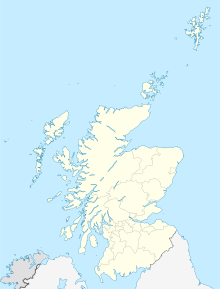| Rhapsody | |
|---|---|
 The northwest face of Dumbarton Rock. Rhapsody and Requiem follow the thin diagonal crack in the middle of the face; Requiem veers to a new crack on the right when the crack begins to disappear. | |
| Location | Dumbarton Rock, Scotland |
| Coordinates | 55°56′14″N 4°33′54″W / 55.93722°N 4.56500°W[1] |
| Climbing area | Dumbarton Rock |
| Route type | Traditional climbing |
| Vertical gain | 35 m (115 ft)[1] |
| Pitches | 1 |
| Grade | Rhapsody: E11 5.14c (8c+) R/X Requiem: E8 5.13b (8a) R |
| First free ascent | Rhapsody: Dave MacLeod 9 April 2006[2] Requiem: Dave Cuthbertson 6 July 1983[3] |
Rhapsody is a 35-metre (115 ft) long traditional climbing route up a thin crack on a slightly overhanging vertical basalt rock face on Dumbarton Rock, in Scotland. When Scottish climber Dave MacLeod made the first free ascent in 2006, it became Britain's first-ever E11-graded route, and at the grade of 5.14c (8c+), Rhapsody was the world's hardest traditional route. It set a grade milestone in traditional climbing that stood for over a decade until the ascent of Tribe at grade E11-12 5.14d (9a) in 2019 and of Bon Voyage at grade E12 5.14d (9a) in 2024.
Rhapsody shares the same central crack-line as another notable traditional climbing route called Requiem (the two routes deviate for the last 10 metres near the top as the crack-line peters out). Scottish climber Dave Cuthbertson made the first free ascent of Requiem in 1983, creating Britain's first-ever E8-graded route. With subsequent ascents, the consensus grade settled at E8 6b or 5.13b (8a), and Requiem is now recognized as being one of the world's hardest rock climbing routes—of any format (i.e. traditional or sport climbing)—at the time it was first ascended in 1983.
